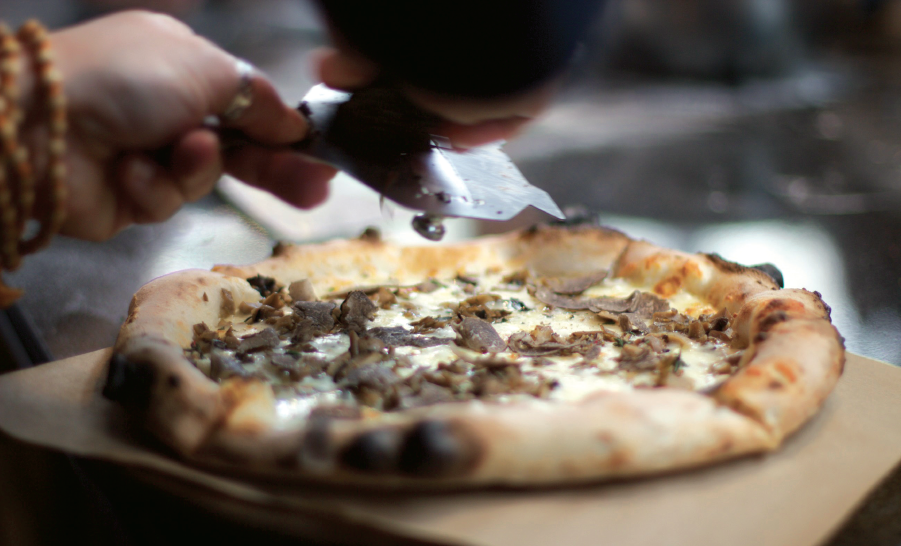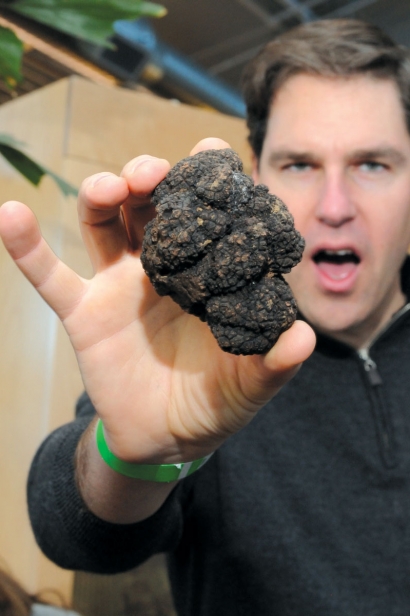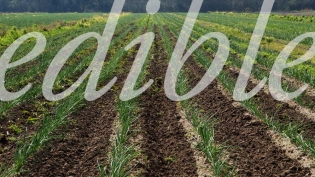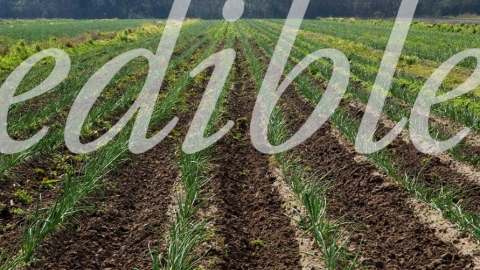There's Something About Truffles
When I saw it, I could not believe it. There I was in early September, standing in a 3 1/2-year-old orchard in Carneros, the sun beating its ferocious wave energy into my skull, and all I saw was parched, dry ground and trees no taller than your average middle schooler. And yet, underground, the slow but steady growth of Tuber melanosporum and Tuber aestivum was underway.
Tuber melanosporum, known colloquially as Périgord or black truffle, and Tuber aestivum, or Burgundy truffle, are two of the most sought-after mycorrhiza in the world. Revered by chefs and beloved by food enthusiasts for their incomparable aroma and flavor, truffles routinely sell for hundreds, if not thousands, of dollars per pound. Their prestige among agricultural products is unquestioned and demand perpetually outstrips supply.
France, the traditional home of Périgord and Burgundy truffles, and Italy, the home of white or Alba truffles (Tuber magnatum), cannot produce enough supply to meet the burgeoning demand for these highly prized flavor nuggets. Each year, the French plant more of the trees that foster the truffle and these new plantings help to meet some of the demand, but natural habitat decline and global economic factors continue to put more pressure on supply.
Freshness is the most important quality of any truffle. A truffle’s aroma begins to dissipate the moment it comes out of the earth. After just four days, the truffle’s aroma is half as strong as when it was unearthed and, in another four days, is half as strong again. The intensity of flavor and aroma of a truffle that has traveled halfway around the globe cannot compare to a newly dug truffle. This freshness, the proximity of the place the truffle was grown to the place where it is consumed, is a key factor in price. In emerging truffle production centers such as New Zealand and Sweden, the desire for truffles arising from one’s own terroir can drive locally produced truffle prices 30% to 40% higher.
This price pressure on local supply creates an opportunity for new cultivators to enter the truffle market. Enter Northern California’s wine country, where truffles are slowly establishing an agricultural toehold.
“There are [currently] no more than 30 acres [of truffles] under production in the US,” says Robert Chang, partner and managing director of the American Truffle Co. (ATC). But Chang and his business partner and chief scientist at ATC, Paul Thomas, are working hard to change that. According to Chang, after years of research in the laboratory and experience in the field, ATC has developed a technologically advanced truffle cultivation methodology and offers growers “the science to compensate for the risk.”
Though the details of their process are shared only with their client partners, their approach is multi-tiered and continues throughout the process from planting to harvest. At ATC’s tree nursery in Oregon, the company inoculates filbert and English oak saplings with truffle spores. The inoculated trees are then delivered to client-partners with whom the company has already collaborated to determine the best planting locations for the trees. In this, factors are considered from the composition and pH levels of soil to water levels and runoff, site preparation and land management.
ATC’s business model is to remain invested in the grower’s success as part-owner of the resulting harvest—percentages vary and are covered by nondisclosure agreements with each partner, but are never more than a third.
Like other tree crops and similar to wine grapes, truffles are not harvested at all for the first few years the tree is in the ground. It takes about five years for the tree to “get comfortable” and its truffle-inoculated roots to develop the symbiotic relationship with the fungi that both require to grow and flourish. Though the first harvest is usually small, ATC says its trees increase their yield every year for the next three to five years before the yield plateaus. Thereafter, the yield generally remains stable, much like grapevines, for generations.
Currently, ATC is working with a handful of wine grape growers in Napa and Sonoma to plant truffle-spore-inoculated trees on their properties. Some of these local folks are, for varying reasons, keeping their truffle-growing activities under wraps for now, but ATC client-partners Rob and Maria Sinskey of Robert Sinskey Vineyards allow their truffle orchard to be used as an ATC showcase. The Sinskeys farm all of their properties with an over-arching belief in developing an entire vineyard ecosystem, one that leaves a minimal footprint on the land, incorporates farm animals and fosters wild-animal-friendly habitat (including fish).
Of the Sinskeys’ 200 farmed acres in Carneros, one acre of sloping land amidst the vines is a new orchard, planted nearly four years ago with truffle-inoculated English oak and filbert trees. Roughly half of the trees were inoculated with Périgord truffle spores and the other half with Burgundy truffle spores. (Though Chang has had success inoculating tree roots with Tuber magnatum in the lab, white truffles are extremely difficult to cultivate and are not currently commercially viable.)
“I’m hedging,” says Sinskey, who grazes a flock of sheep amidst the vines and trees. “I need to keep the land open for the sheep, and in 15 years I will have a nice orchard to eat lunch in,” he says.
But, if it works, the financial rewards could be significant. Périgords fetch as much as $1,200 per pound on the open market (there are black markets for truffles) and Burgundys fetch as much as $700 per pound. “But Burgundy truffles yield two to three times as much per acre as Périgords,” says Chang. The differing yields mean that revenues per acre of Périgord and Burgundy are roughly equivalent.
The Sinskeys’ agreement with ATC means Maria Helm Sinskey, Rob’s wife and the chef and culinary director at her husband’s winery, can keep as many of the truffles that will eventually come out of their orchard as she wants.
“It is not a losing proposition,” says Rob Sinskey, “even if we only get a little.” He is expecting an initial harvest in about two years.
“If you already have a vineyard, putting in truffle trees is very straightforward,” says Chang, who notes the environmental as well as operational synergies.
Truffle trees offer wineries an alternative to the grapevine monoculture and also provide other environmental benefits. Many farmers in wine country need flood control tools and sustainable alternatives to grapevines as buffers in riparian zones. Unlike grapevines, the roots of oak and filbert trees help hold soil in place, an important factor in water resource management and conservation. By preventing soil and water runoff, tree roots reduce negative downstream effects of that runoff. Soil retention also keeps water where it is needed most, on the tree’s roots, where it works in partnership with the soil to nourish the plant. A benefit to farmers as well as to the overall environment, holding soil in place reduces the amount of irrigation needed for any crop. “I am always looking for ways to use less water,” says Sinskey.
On a larger scale, California’s “cap and trade” system for carbon offsets that took effect in 2012 may mean that these new “tree growers” are able to sell offsets from planting trees to the carbon marketplace. According to a speech given by Chang at the Sonoma Farm Bureau this September, ten acres planted with trees offsets the carbon footprint of 450 cars.
Cultivated truffles, once the domain of a few family farms in Europe, appear to be putting down roots in the New World. Fittingly, a few pioneers in our own region are at the forefront of bringing this exciting and delicious industry to American soil. Farmers like Rob Sinskey, guided by an interest in bio-diverse farming, and chefs like Maria Helm Sinskey, who seek the culinary adventure of cooking with truffles, are early adopters, willing to share some of the risk to nurture the development of this extraordinary fungi.
Like many things in life, the environmental and financial benefits of planting truffle-inoculated trees will take time to harvest. Today’s sun-baked mini-orchard could be the home of tomorrow’s aromatic, umami-laden truffles and, in the not-too-distant future, a region renowned for growing wine grapes could be known as much for what grows below ground as above. See the future? Actually, this time you can smell it.
PICK UP THE TRUFFLE TRAIL
The Napa Truffle Festival, sponsored by the American Truffle Co. (ATC), was launched in 2010 to increase awareness of truffles as a viable crop for cultivation and consumption in California. In only four years, the festival has become the premier North American truffle cultivation and cooking showcase.
In its first year, the truffle festival focused on providing seminars for potential growers and farmers. More recently, the festival has expanded to include a marketplace and chef demonstrations designed to educate a broad range of consumers on the unique character, flavor and texture that truffles bring to the table.
This year’s festival will take place January 17–20, and kicks off with an in-depth scientific truffle cultivation seminar, targeted to potential growers.
On Saturday afternoon, vintner and new truffle farmer Rob Sinskey will open his orchard for a tour and dog-training demonstration. Found as little as one-quarter inch but not more than two inches below the Earth’s surface, “black diamonds,” as truffles are fondly nicknamed, are now mainly harvested with the help of dogs. Unlike pigs, the old-school animal of choice to unearth truffles, dogs do not care to eat the truffles they find, but receive other rewards (not so dear) for their good work.
“Any dog can be trained to hunt for truffles,” says ATC’s Robert Chang, who works with dog trainers and makes dog training available for his client-partners.
Though not “black diamonds,” other edible fungi such as chanterelles and porcinis will be the goal of a Sunday mushroom forage with forager David Campbell and mycologist Stephanie Jarvis.
If your interests do not involve the art and science of the truffleur but rather the nose and palate of a gourmandize, numerous opportunities to sample truffles await. Michelin-starred chefs, such as Ken Frank of Napa’s La Toque restaurant; Alessandro Boglione of Ristorante al Castello at the historic Castello di Grinzane di Cavour in Piemonte, Italy; and Carrie Nahabedian of Chicago’s NAHA restaurant will be on hand to bring aromatic life to the joy of cooking with truffles. Two Napa wineries, Hall and Nickel & Nickel, will pair truffles with house wines, cooking demonstrations and lunch prepared by still more Michelin-starred chefs.
The truffle festival marketplace on Monday captures the democratic spirit of the festival. Held at Napa’s Oxbow Public Market, the truffle festival marketplace is free and open to the public. Every one of the restaurants inside the market plans to offer à la carte dishes featuring truffles. According to some of last year’s attendees, the incomparable aroma of fresh truffles will rev your olfactory sensors into high gear even as you enter the building. A sampling of offerings from past festival marketplaces includes roasted prime rib with truffle vinaigrette, truffled wild mushroom and goat cheese enchiladas, boquerone crostini topped with truffle gremolata, truffled yucca fries and white truffle pizza.
Shops inside the marketplace will also offer take-home truffle treats like truffled triple-cream brie and truffle popcorn, and teas, coffees and wines that partner well with truffles.







